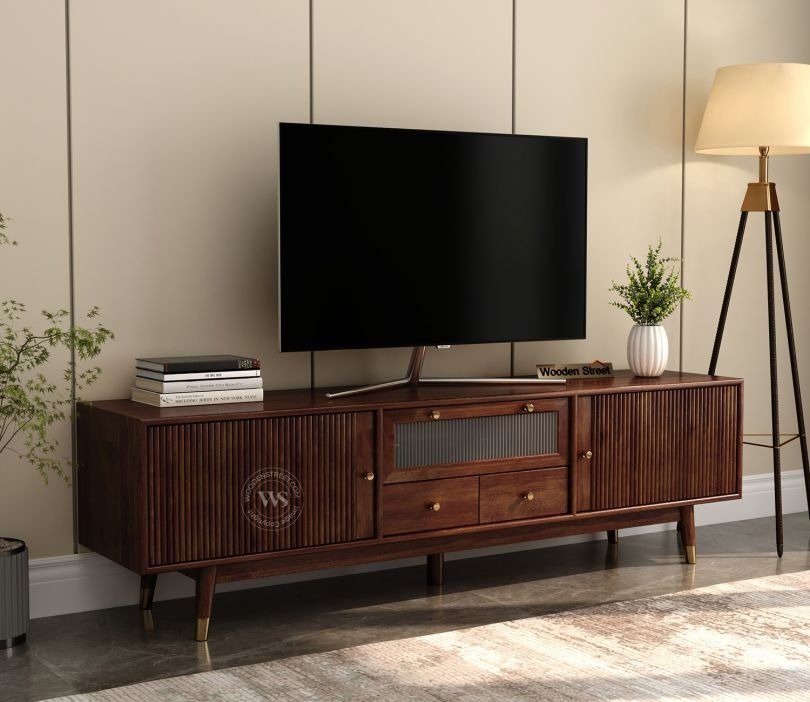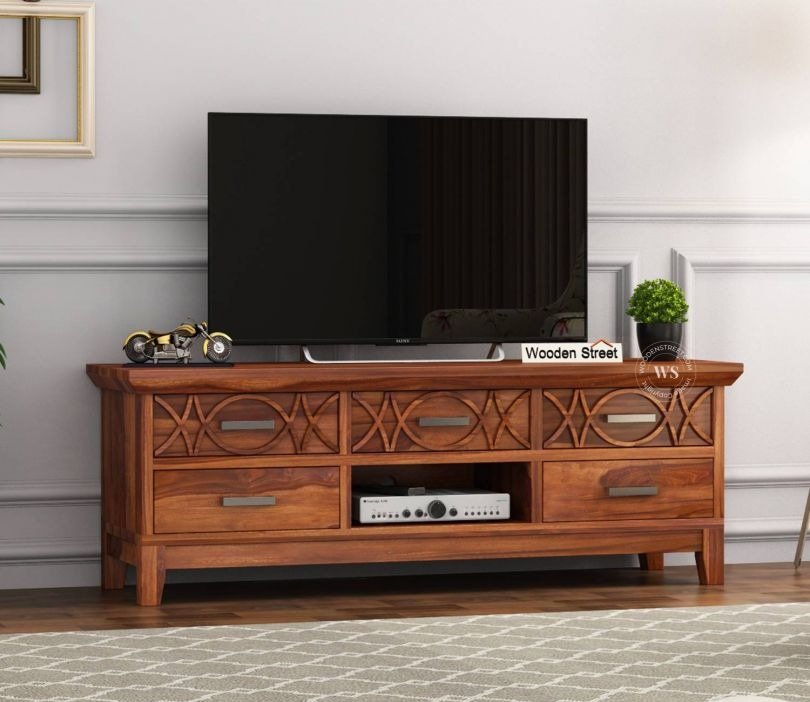Introduction
A TV unit is no longer just a place to set your television it’s the focal point of your living room, influencing both the aesthetics and functionality of the space. The right TV cabinet or TV stand not only houses your entertainment system but also helps with storage, cable management, and interior styling. From a sleek wooden TV unit to a space-saving wall-mounted design, your choice should complement your layout, enhance comfort, and blend seamlessly with your home’s personality.
In this guide, we’ll explore everything you need to consider from sizing and style to placement and storage so you can choose the perfect TV unit for your living room.
1. Assess Your Living Room Layout First
Before you even start browsing designs, you must understand your room’s layout. Ask yourself:
- Where will the TV be placed for optimal viewing?
- How much wall or floor space is available?
- Is natural light going to cause glare on the screen?
- Will the unit disrupt traffic flow?
For small rooms, a wall-mounted TV stand or corner unit can help save space. In larger spaces, a wide wooden TV cabinet with storage drawers can double as both a design statement and a functional piece.
2. Decide on the Functionality
Not all TV unit are created equal their purpose can vary:
- Storage-oriented: Ideal if you have gaming consoles, remotes, speakers, or decorative items.
- Minimalist display: For those who prefer a clean, clutter-free look with minimal shelves.
- Multi-purpose: Units that also act as display cabinets, bookshelves, or room dividers.
A TV unit for living rooms that offers closed cabinets helps hide clutter, while open shelves allow for decorative displays.
3. Pick the Right Style
Your TV unit should align with your living room’s overall theme.
- Wooden TV Unit: Timeless and versatile, suitable for both modern and traditional homes.
- Minimalist Floating TV Stand: Perfect for contemporary and small spaces, giving a light, airy feel.
- Industrial Style: Combining metal frames with wood, this design adds character to urban interiors.
- Rustic Farmhouse Cabinet: Creates a warm and homely ambiance.
Choosing the wrong style can disrupt visual harmony, so match materials, colors, and finishes with existing furniture.
4. Size Matters
A well-proportioned TV unit ensures comfort and aesthetics:
- Width: Your TV unit should be slightly wider than your television to provide stability and visual balance.
- Height: Position the TV so that the center of the screen aligns with your seated eye level.
- Depth: Ensure there’s enough space for media devices, but not so deep that it overwhelms the room.
For example, a 55-inch TV generally pairs well with a 60–65-inch wide TV stand.
5. Placement for Optimal Viewing
The placement of your TV cabinet depends on both the viewing experience and room flow:
- Avoid placing the TV opposite large windows to reduce glare.
- Maintain a comfortable viewing distance (about twice the diagonal screen size).
- Ensure seating arrangements are angled for easy viewing without neck strain.
- In open-plan layouts, use the TV unit as a subtle divider between zones.
6. Storage and Cable Management
No one likes messy wires dangling behind their entertainment setup. Look for TV stands with:
- Built-in cable holes or channels to hide wires.
- Shelves or compartments for speakers, gaming consoles, and media players.
- Drawers for storing remotes, DVDs, and accessories.
A wooden TV unit with a mix of open and closed storage strikes the perfect balance between accessibility and tidiness.
7. Choosing the Right Material
The material affects durability, maintenance, and appearance:
- Solid Wood: Sturdy, long-lasting, and offers a natural, warm feel.
- Engineered Wood: Affordable and available in a variety of finishes.
- Metal & Glass: Sleek and modern but requires frequent cleaning.
- Mixed Materials: A trendy option that blends durability and style.

A wooden TV unit remains a popular choice for its durability and timeless appeal.
8. Colour Coordination
Your TV unit should complement — not clash with — your living room color scheme.
- Light wood tones work well in Scandinavian or airy interiors.
- Dark woods create a sense of luxury and contrast in bright rooms.
- White or pastel units suit minimalist and contemporary designs.
9. Lighting & Décor Integration
Enhance your TV unit’s appeal with thoughtful décor:
- Add LED strip lighting for a modern touch.
- Style open shelves with plants, photo frames, or books.
- Use decorative baskets or boxes to store small items.
- Keep the décor minimal to prevent distraction from the screen.
10. Trends in TV Unit Design
If you’re looking for inspiration, here are current design trends:
- Floating Wall Units: Save space and give a clean look.
- Sustainable Materials: Eco-friendly woods and finishes are in demand.
- Multi-Functional Units: Combining workspaces, shelves, and display areas.
- Asymmetrical Designs: Offering a modern, artistic feel.
11. Budget Planning
Prices for TV units can vary widely:
- Budget range: Simple engineered wood or metal units.
- Mid-range: Solid wood units with storage.
- Premium: Designer pieces with integrated lighting, sliding panels, or custom builds.
Remember: A well-made TV cabinet is an investment that will last years, so balance affordability with quality.
12. Measuring & Shopping Tips
Before buying:
- Measure your TV’s dimensions.
- Check the available space in your living room.
- Consider the height and viewing comfort.
- Leave extra room for future upgrades (e.g., a larger TV).
When shopping online, read reviews, check material specifications, and ensure the product comes with warranty details.
Conclusion
The perfect TV unit for your living room is one that meets your storage needs, fits your space, matches your style, and enhances your viewing comfort. Whether you choose a rustic wooden TV stand, a sleek floating unit, or a multifunctional media wall, the key is to find a balance between function and design.
By taking the time to measure, plan, and align your purchase with your living room’s layout, you can transform your TV corner into a stylish focal point that’s both practical and visually pleasing.


